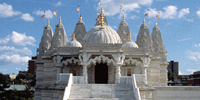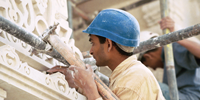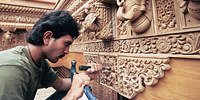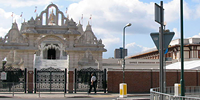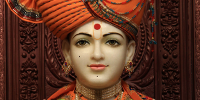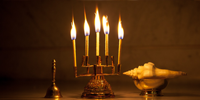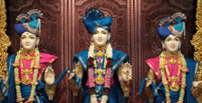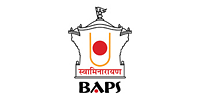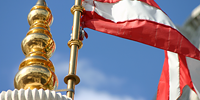Parts of a Mandir
A Hindu mandir is composed of many parts, each with a distinct description, function and representation detailed in Hindu texts.
The diagrams below show the various parts of a traditional mandir. Click on each of the names to read a brief explanation.
- Jagati – Base or lower layer of the mandir
- Mandovar – Exterior wall of the garbh-gruh and maha-mandap, decorated with various sculptures of celestial beings, sages, seers and enlightened devotees as well as depictions of important stories from Hindu scriptures
- Gavaksh – Decorative closed windows adorning both the shikhar and mandovar
- Jharukha – Small balconies with enclosed balustrades looking out from upper-floor windows
- Roopchoki – Porch entrance leading into the vestibule before the maha-mandap
- Ghummat – Central dome
- Gummati – Smaller domes, or cupolas accompanying the main dome
- Urushrung – Small towers attached to the main shikhar
- Shikhar – Spire, or an intricate set of sculpted towers, rising over the garbh-gruh of each shrine
- Amalak – Circular stone that caps the shikhar and upon which rests the kalash
- Kalash – Finial placed atop the shikhar, formed by a series of progressively smaller gilded urns
- Dhvaj-Sthamb – Flag mast rising above each shikhar, usually topped with bells
- Dhvaj – Flag
- Gopuram – Ceremonial gateway leading into the mandir precinct
- Garbh-Gruh – Sanctum sanctorum; the innermost chamber and a place of inviolable sanctity housing the murtis, or sacred images of the Deities. Literally meaning ‘womb housing the embryo’, i.e. the source of life for the mandir, the garbh-gruh is considered its most sacred part.
- Maha-Mandap – Pillared sanctum (or nave) from where devotees look into the garbh-gruh for darshan of the murtis
- Mukh-Mandap – Front-facing decorative pillared section of the maha-mandap parallel to the garbh-gruh
- Pradakshina-Path – Passage used for circumambulations that circles the garbh-gruh and frequently the maha-mandap
- Sthambh – Column
- Toran – Arch
- Chhat – Ceiling
Mandirs as a Form of the Divine
Ancient Hindu builders saw the mandir not just as a sacred structure, but as an actual form of God. Vedhavastu-Prabhakara, Shilpa-Ratnakara and other treatises extensively describe the mandir as ‘devaswarupa’ – literally, ‘God’s body’.
The diagram and table below show various parts of a mandir and their corresponding representation of the body of God:
|
Mandir Part |
Mandir Part |
Representation of |
|---|---|---|
| Pada-Shila | Foundations | Feet |
| Sthambh | Columns | Knees |
| Shila | Stone Blocks | Bones |
| Yavva | Mortar | Muscles |
| Foundation up to Jagati | Lower Layer | Thighs |
| Garbha-Gruh | Inner Sanctum | Stomach |
| Madhyasthan | Central Altar for Murti | Navel |
| Sinhasan | Shrine for Murti | Heart |
| Murti | Sacred Image | Soul |
| Shikhar | Spires | Shoulders |
| Ghant | Bell | Tongue |
| Gavaksh | Windows | Ears |
| Shukanas | Part of the Shikhar (literally, ‘parrot beak’) |
Nose |
| A malaka | Crown of the Shikhar | Neck |
| Kalash | Finial Urns atop the Shikhar | Head |
| Dhvaj | Flag | Hair |
